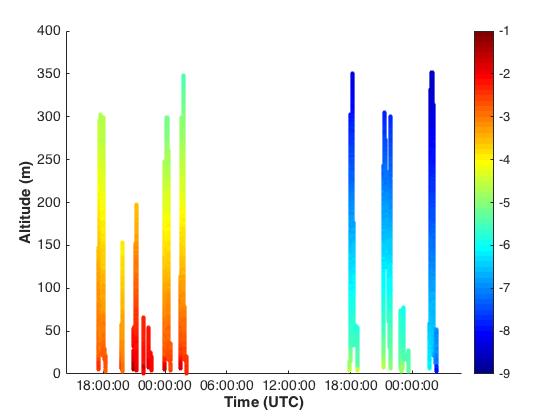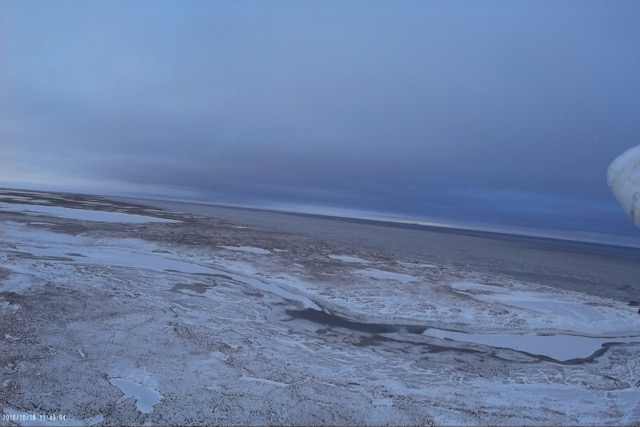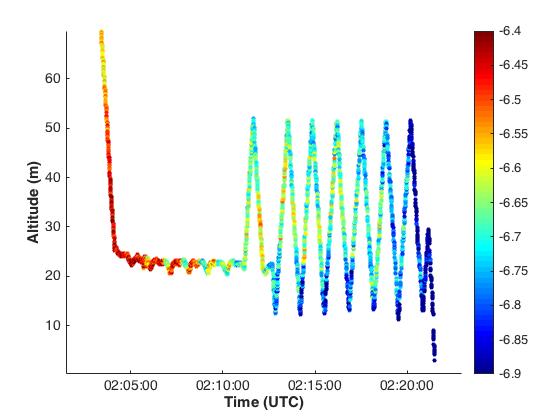
The newly forming sea ice offshore. We spent quite a bit of time sampling this today, and tonight’s cold temperatures should provide more opportunities to sample it tomorrow!
It was another fantastic day of flights at Oliktok Point! With the weather continuing to provide opportunities for flight, Doug and I took full advantage and completed another six flights. While six flights might not seem like a lot, several of these were starting to push 45 minutes in length. In addition, the rapidly declining amount of daylight only provides us with so much time during the day to get our flights in – this morning we were not able to fly until around 9:30 am, and we had to put the last flight down around 6:20 pm. When you combine all of this with the cold weather, it makes for a pretty full and active day — in total, we’ve completed 13 flights over the last two days, totaling over 330 minutes of flight time!

Profiles of temperature measured by the DataHawks over the last two days. Today was a lot colder than yesterday!
I started the day in the dark on the phone with colleagues back in the lower 48 to make some repairs on one of the instruments we brought up to fly on the tethered balloon. While it’s not much fun waiting for the sun to come up, it is an excellent opportunity to take care of some housekeeping items such as this. After the adjustments, the instrument was once again working well and ready for deployment into the Arctic sky tomorrow! We started the day’s flights with some profiles up toward the low cloud cover that was overhead. In addition, we completed some low-altitude flights to get some samples of the spatial variability near the surface over a variety of surface types, including tundra, frozen ponds and the river.
After this, we switched to a second DataHawk, which was equipped with a couple of cameras so that we could capture both video and photographs of the Oliktok environment. We got some great shots of the day’s weather from the air, including a nice photograph of the AMF-3 and the ARM tethered balloon. From here, we did some more profiling and then headed back to the beach for our next “flux” flight over the newly forming sea ice. Admittedly, this flight takes a lot out of Doug and myself. Buzzing over the ocean at 20 meters altitude doesn’t leave much room for error, so both the pilot and operator are very, very focused on every little thing that the plane is doing during that time. I’m happy to report that for the second straight day, and third time this trip, we successfully completed this flight — the airplanes have been flying very well! Together, these flux flights will provide critical information on how the transfer of energy from the surface to the atmosphere is evolving as the ice gets thicker. Hopefully conditions will give us a few additional days.

A DataHawk’s view of the sea ice and tundra today at Oliktok Point. The white thing on the right of the image is the nose of the aircraft.

The AMF-3 and ARM tethered balloon, as seen by a DataHawk.
At the end of the day, we completed some more profiling, including an extended period of profiling between 10 and 50 meters altitude. This was a bit of an “on the fly” decision made to sample a developing stable “inversion” layer. With the clouds thinning out, and the sun going down, the lower atmosphere began to cool very rapidly. This is one of the great things about these platforms – you can target specific areas of interest as they develop!

A developing surface inversion layer, as seen by the DataHawk as the sun went down today.
Tomorrow is certain to be another busy day for both the DataHawk and the tethered balloon crews. Time to get some rest!
